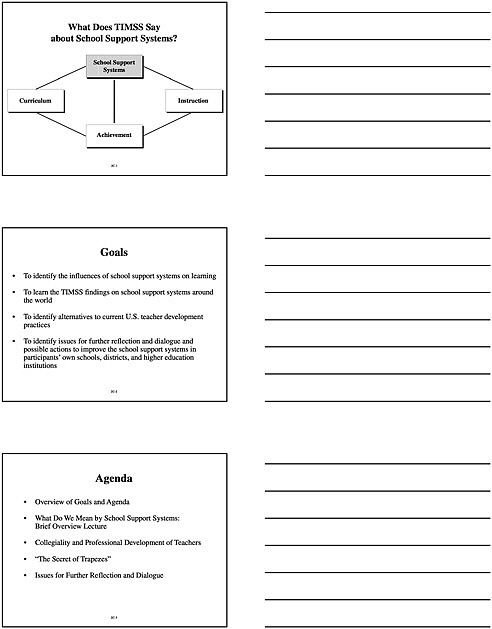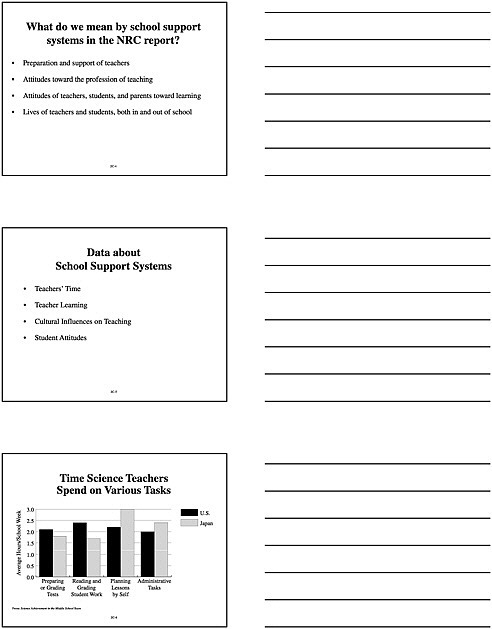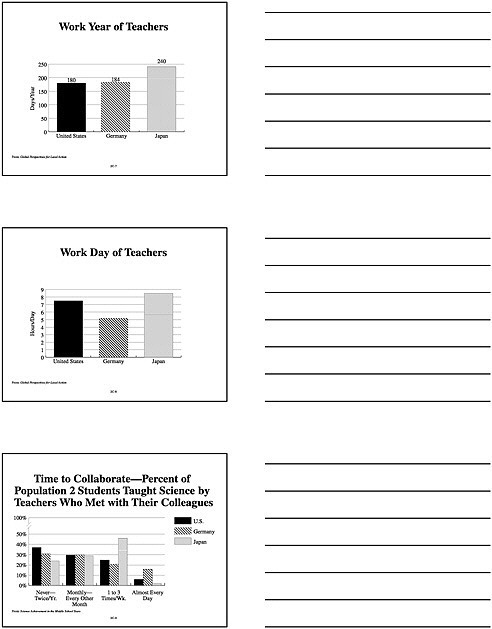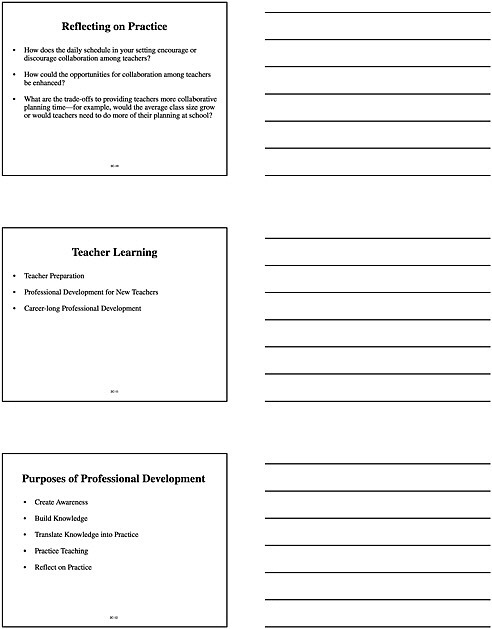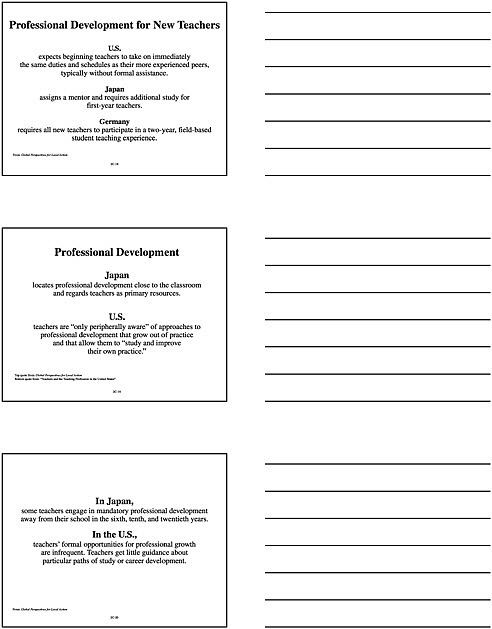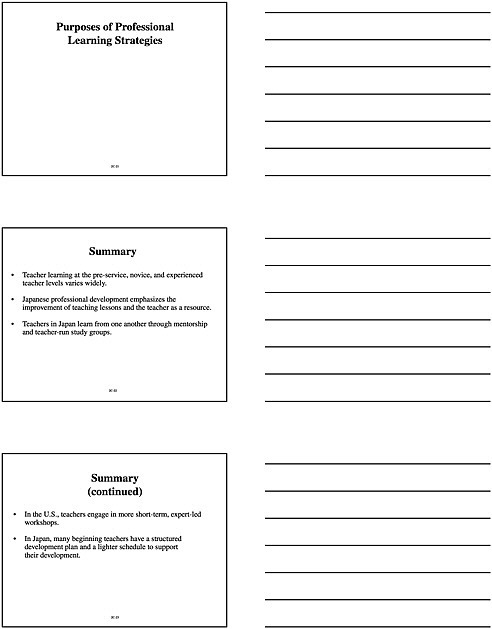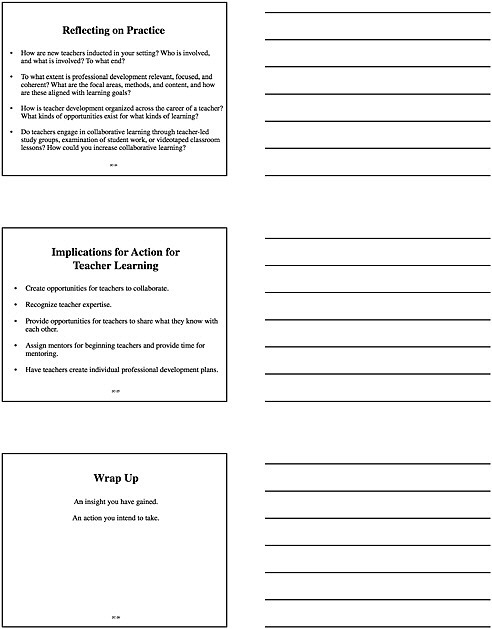Strategies for Professional Learning
|
STRATEGIES |
PURPOSES* |
|
|
1. |
Immersion in Inquiry into Science and Mathematics: Engaging in the kinds of learning that teachers are expected to practice with their students—that is, inquiry-based science investigations or meaningful mathematics problem solving. |
 |
|
2. |
Immersion into the World of Scientists and Mathematicians: Participating in an intensive experience in the day-to-day work of a scientist or mathematician, often in a laboratory, industry, or museum, with full engagement in research activities. |
|
|
3. |
Curriculum Implementation: Learning, using, and refining use of a particular set of instructional materials in the classroom. |
|
|
4. |
Curriculum Replacement Units: Implementing a unit of instruction that addresses one topic or concept and incorporates effective teaching techniques and learning strategies to accomplish learning goals. |
|
|
5. |
Curriculum Development and Adaptation: Creating new instructional materials and strategies or tailoring existing ones to meet the learning needs of students. |
|
|
6. |
Workshops, Institutes, Courses, and Seminars: Using structured opportunities outside the classroom to focus intensely on topics of interest, including science or mathematics content, and learn from others with more expertise. |
|
|
7. |
Action Research: Examining teachers’ own teaching and their student’s learning by engaging in a research project in their classroom. |
|
|
8. |
Case Discussions: Examining written narratives or videotapes of classroom teaching and learning and discussing what is happening, the problems, issues, and outcomes that ensue. |
|
*PURPOSES:
-
Strategies that focus on developing awareness are usually used during the beginning phases of a change, which calls for introducing teachers to new approaches or content. The strategies are designed to raise awareness through the introduction of new information and to elicit thoughtful questioning on the part of the teachers concerning the new information.
-
Strategies that focus on building knowledge provide opportunities for teachers to increase their understanding of science and mathematics content and teaching practices.
-
Strategies that help teachers translate new knowledge into practice engage teachers in drawing on their knowledge base to plan instruction and improve their teaching.
-
Strategies that focus on practicing teaching help teachers learn through the process of using a new approach, practice, or process with their students. As they practice new moves in their classrooms, they increase their understanding and their skills.
-
Strategies that provide opportunities to reflect deeply on teaching and learning engage teachers in examining their experiences in the classroom, assessing the impact of the changes they have made on their students, and thinking about ways to improve. The strategies also encourage teachers to reflect on others’ practice, relating it to their own and generating ideas for improvement.
Strategies for Professional Learning
|
STRATEGIES |
PURPOSES |
|
|
9. |
Study Groups: Engaging in regular, structured, and collaborative interactions regarding topics identified by the group, with opportunities to examine new information, reflect on their practice, or assess and analyze outcome data. |
 |
|
10. |
Examining Student Work and Student Thinking and Scoring Assessments: Carefully examining students’ work and products to understand their thinking and learning strategies and identify their learning needs and appropriate teaching strategies and materials. |
|
|
11. |
Coaching and Mentoring: Working one-on-one with an equally or more experienced teacher to improve teaching and learning through a variety of activities, including classroom observation and feedback, problem solving, and co-planning. |
|
|
12. |
Partnerships with Scientists and Mathematicians in Business, Industry, and Universities: Working collaboratively with practicing scientists and mathematicians with the focus on improving teacher content knowledge, instructional materials, access to facilities, and acquiring new information. |
|
|
13. |
Professional Networks: Linking in person or through electronic means with other teachers or groups to explore and discuss topics of interest, set and pursue common goals, and address common problems. |
|
|
14. |
Developing Professional Developers: Building the skills and knowledge needed to create learning experiences for other educators, including design of appropriate professional development strategies; presenting, demonstrating, and supporting teacher learning and change; and understanding in depth the content and pedagogy required for effective teaching and learning of students and other educators. |
|
|
15. |
Technology for Professional Learning: Using various kinds of technology, including computers, telecommunications, videoconferencing, and CD-ROMs and videodiscs to learn content and pedagogy. |
|
|
“Strategies for Professional Learning” table adapted from Designing Professional Development for Teachers of Science and Mathematics by Susan Loucks-Horsley, Peter W.Hewson, Nancy Love, and Katherine E.Stiles, with Hubert M.Dyasi, Susan N.Friel, Judith Mumme, Gary I.Sneider, and Karen L.Worth (Thousand Oaks, CA: Corwin Press, 1998). The book is a product of the National Institute for Science Education, funded by the National Science Foundation. *The “Purposes” section of this table was adapted from a framework devised by QUASAR project researchers (Brown and Smith, 1997). |
||

